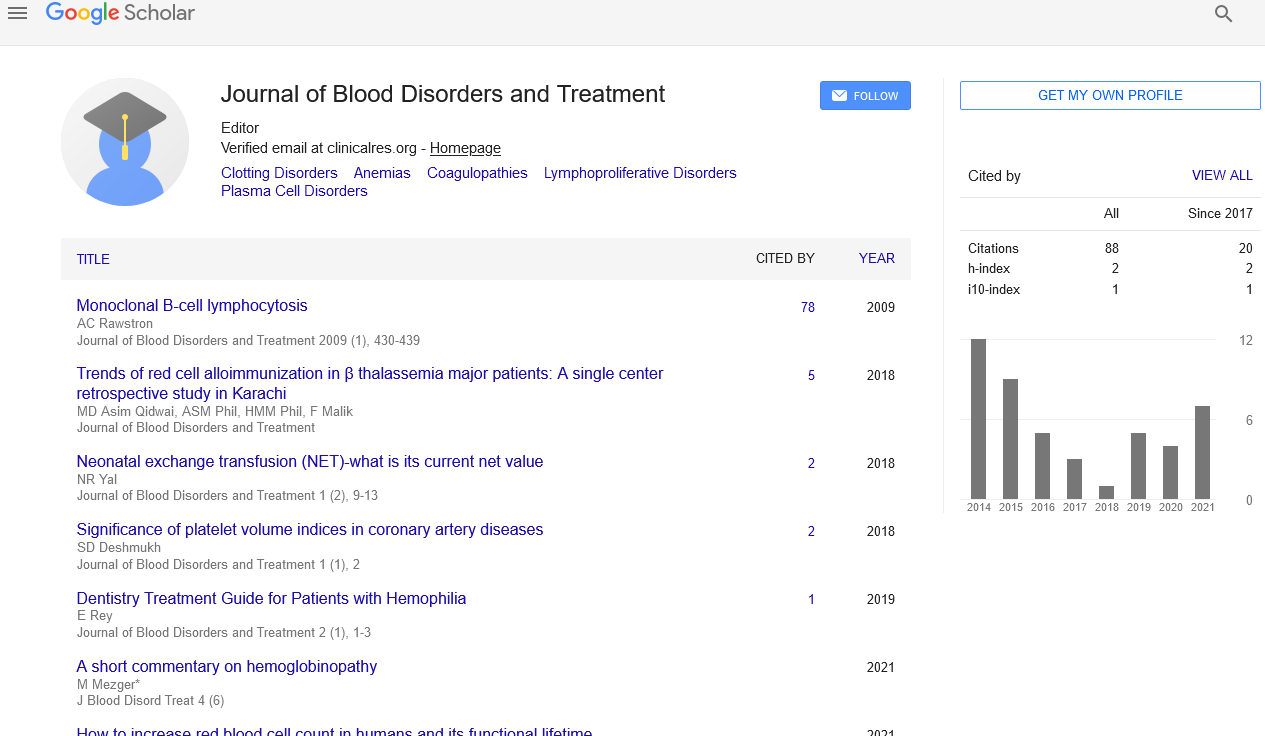Editorial Note on Hodgkin Lymphoma
Ukraine
, Ukraine,Received: 02-May-2021 Accepted Date: May 15, 2021; Published: 22-May-2021
This open-access article is distributed under the terms of the Creative Commons Attribution Non-Commercial License (CC BY-NC) (http://creativecommons.org/licenses/by-nc/4.0/), which permits reuse, distribution and reproduction of the article, provided that the original work is properly cited and the reuse is restricted to noncommercial purposes. For commercial reuse, contact reprints@pulsus.com
Abstract
Introduction
Hodgkin lymphoma (HL) is a remarkable hematopoietic neoplasm described by dangerous Reed-Sternberg cells in an incendiary foundation. Patients are usually analyzed when in their 20s-30s, present with supradiaphragmatic lymphadenopathy, frequently with foundational B indications. Indeed, even in cutting edge stage infection, HL is exceptionally reparable with mix chemotherapy, radiation or consolidated methodology therapy. Albeit a similar ABVD chemotherapeutic routine has been the backbone of treatment for over most recent 30 years, hazard adjusted methodologies have helped de-raise treatment in generally safe patients while strengthening treatment for higher danger patients. Indeed, even patients who are not restored with introductory treatment can frequently be rescued with substitute chemotherapy blends, the novel neutralizer drug form Brentuximab, high portion autologous or allogeneic hematopoietic immature microorganism relocate (allo-HCT) [1].
The Programmed demise 1 (PD-1) inhibitors Nivolumab and Pembrolizumab have both shown high reaction rates and sturdy reductions in backslide/recalcitrant HL. Substitute contributor sources and decreased force molding have made allo-HCT a practical alternative for more HL patients. Future exploration will hope to incorporate novel techniques into prior lines of treatment to improve the HL fix rate and limit long haul treatment poison levels.
Hodgkin lymphoma is assessed to represent about 10% of instances of recently analyzed lymphoma in the United States (8,260 of 80,500), the rest of Non-Hodgkin lymphoma. Of 21,210 assessed passings yearly because of lymphoma, around 1,070 (or 5%) are from Hodgkin lymphoma. It represents about 0.5% of recently analyzed instances of disease in the United States and about 0.2% of all malignancy passings. Anyway lymphoma is the most well-known malignancy analyzed in youths (matured 15 to 19 years) representing 21% of new judgments, very nearly 66% of which is Hodgkin lymphoma [2]
The etiology of HL isn't surely known. Epstein-Barr infection (EBV) is a pervasive gammaherpesvirus spread fundamentally through spit and is the causative specialist for irresistible mononucleosis. EBV-encoded little RNAs (EBERs) are noncoding RNAs communicated bounteously in idly EBVtainted cells and can be recognized by in situ hybridization (ISH). EBV is identified in HRS cells in a lion's share of HL examples from the creating scene, however substantially less every now and again in the industrialized nations of North America and Western Europe.
The danger of creating EBV-positive HL is fundamentally expanded (relative danger, 4.0; 95% CI 3.4 to 4.5) after a scene of irresistible mononucleosis, with an expected middle brooding season of 4.1 years (95% CI 1.8 to 8.3). Notwithstanding, the supreme danger of creating HL after irresistible mononucleosis stays little at roughly 1 out of 10007. Plasma EBV-DNA inspiration is an autonomous indicator of treatment disappointment, both at analysis and on half year circle back to treatment [3]
REFERENCES
- Hodgkin On some Morbid Appearances of the Absorbent Glands and Spleen. Medico-chirurgical transactions. 1832;17:68–114.
- Jaffe ES, H N, Stein H, Vardiman JW. World Health Organization Classification of Tumours: Pathology and Genetics of Tumours of Haematopoietic and Lymphoid Tissues. IARC; Lyon: 2001.
- Siegel RL, Miller KD, Jemal A. Cancer statistics, 2017. CA: a cancer journal for clinicians. 2017;67(1):7–30.





